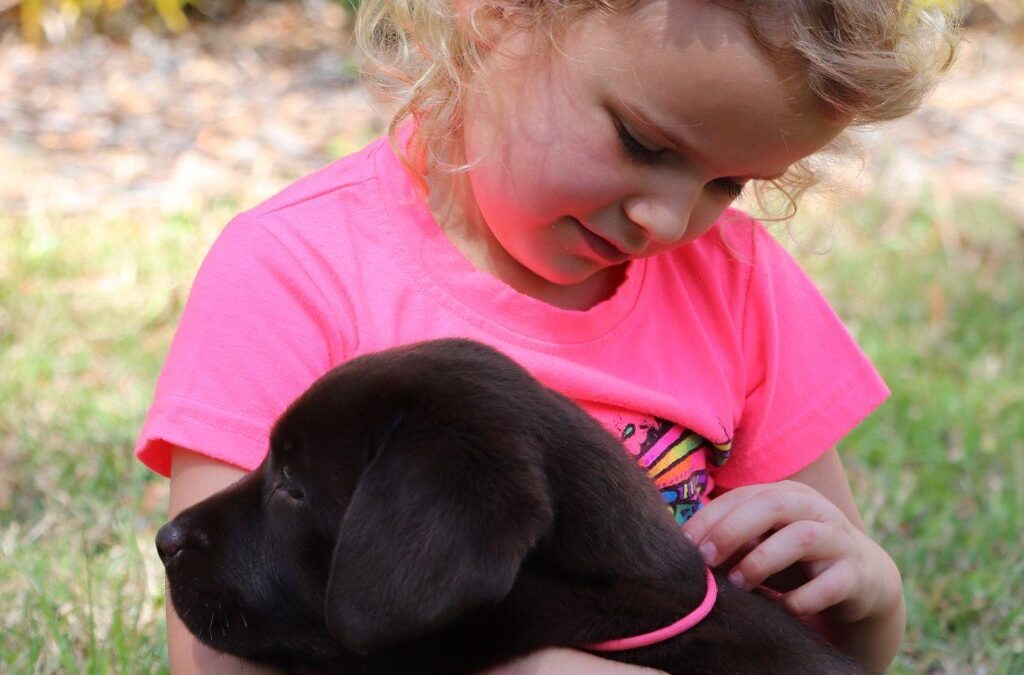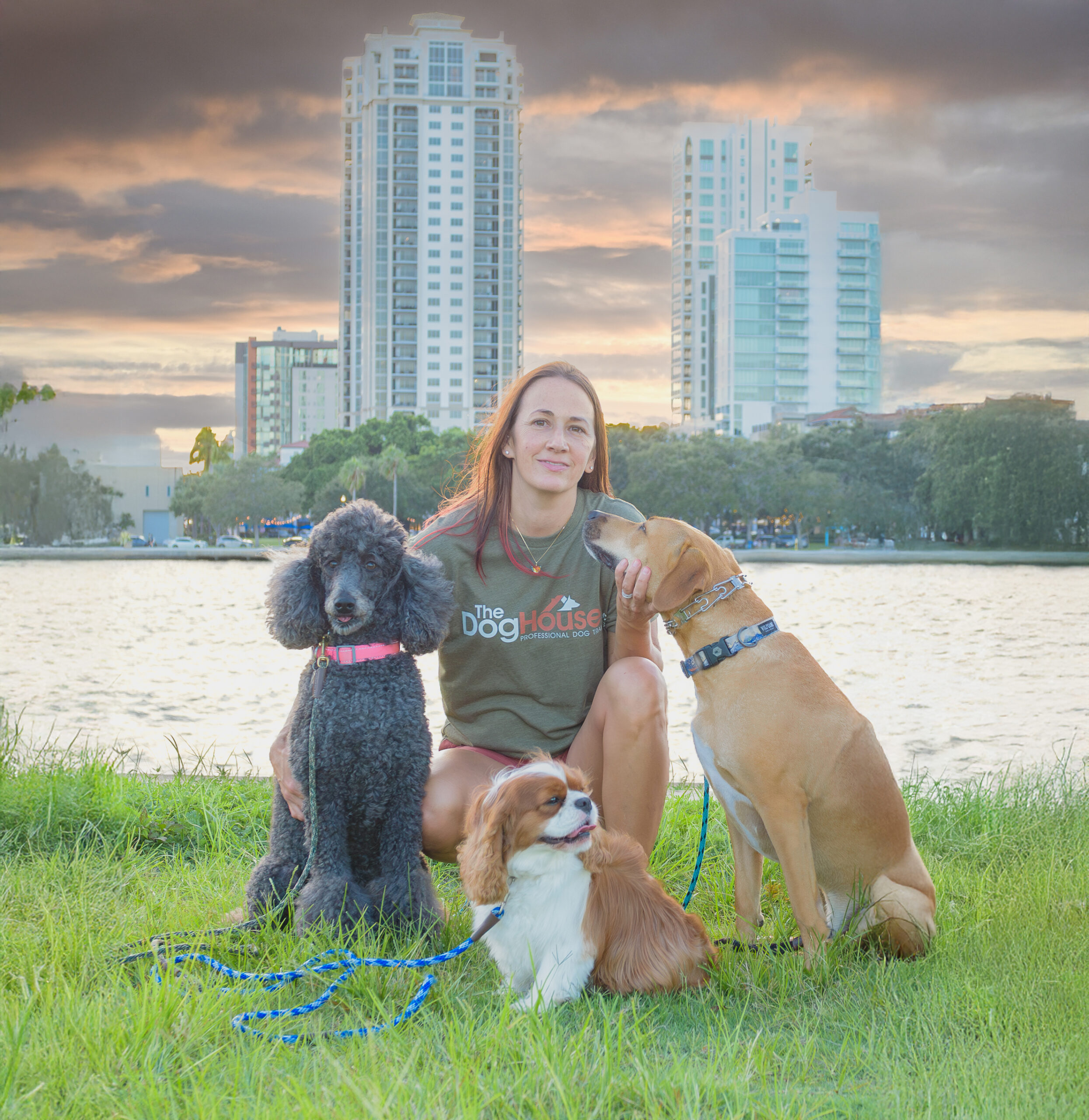Most puppies go home to their new families at around eight weeks old. Until then, they have been wrestling, playing, and establishing their hierarchy among their littermates.
Puppies engage in mouthing, nipping, growling, and pinning as forms of play and status. During these interactions, correction, boundaries, and respect are dynamically being learned among the litter.
*It’s important to remember that these behaviors are a normal part of a puppy’s development.
If your puppy keeps biting and you’re not sure what to do, you’re in the right place. This post from The Dog House will help you understand why puppies nip and how to gently teach them better habits.
Why Puppies Bite (and Why It Surprises First-Time Owners)
When your puppy first arrives, this playful mouthing can become their first form of interaction with humans if you don’t intervene immediately. Many first-time dog owners are surprised by how nippy their puppies can be.
This period of transition is a critical time for you to teach your puppy correct bite inhibition and redirect your puppy’s natural inclination to use their mouths on inappropriate objects, such as:
- Hands
- Clothes
- Shoes
To more suitable objects, like:
- Interactive toys
- The leather shammy
This base lays the foundation for your puppy to distinguish between interacting with humans rather than past learned dog interactions. It is your job as a new puppy owner to ensure this happens.
Practical Techniques for Teaching Bite Inhibition
The first thing to teach your puppy is what appropriate toys and games they can use their mouth in. I recommend introducing a leather shammy to start channeling their biting towards. Follow this video link for how to introduce this game to your pup.
Additionally, introduce interactive toys such as:
- Nylabones
- Kongs
- Bowls of ice
- High-drive bully sticks (placed in a holder)
These provide puppies with longer engagement and safe outlets to use their teeth.
Put both of these methods in place before moving on to the next section, which entails how to correct your pup when it nips.
Thinking about training soon? Read why spring break is the perfect time to train your dog at The Dog House.
How to Correct Biting Behavior Gently and Effectively
Correcting a biting and nipping puppy should be done in a calm, gentle manner.
For hesitant owners who are afraid of the puppy, I suggest investing in a pair of thick leather gloves for use when interacting with a nippy puppy.
I recommend gently scruffing the pup to regain control during those moments. This technique mimics how a mother dog would correct her puppies by biting the back of their necks and holding them in place.
When your puppy bites or nips at you:
- Calmly say NO
- Gently grasp the back of their neck
- Hold upward while making eye contact
- Release your pup once they settle
Observe how your puppy responds:
- If they walk away, that’s okay
- If they lick or stay by you, don’t start petting right away
- Give the puppy a toy to chew on and remain neutral
Why Hesitation Can Send the Wrong Message to Your Puppy
New owners may feel hesitant or cautious when their puppy nips or bites at them, inadvertently empowering the puppy as if it holds a higher status in the relationship.
This empowerment happens especially with kids who may:
- Run away
- Cry
- Pull back their hands after being nipped
(In their defense, pups have razor-sharp teeth, and it hurts!)
When Play Growling Feels Like a Threat
Some puppies may vocalize with growling while playing, which can also alarm new owners.
Again, this behavior is often a continuation of their interactions with littermates when they compete.
It is usually not a threat or signal that they are escalating aggression.
What to do instead:
Try to hold a position of confidence and leadership around your pup. The puppy senses this and needs you to guide them.
Correction Is Familiar & Not Cruel
Remember, your puppy has been corrected, whether by a littermate or their mom, before you got them.
A perfect example of this is:
- When a puppy’s teeth start coming in and nursing becomes painful for the mother.
- She begins correcting them and setting boundaries for herself.
A mother allowed access to her puppies until 8 weeks, can also oversee the littermate interactions, and help correct behaviors if the puppies are getting too rowdy.
As a breeder myself, this is the best case for your puppy. These interactions among the litter are essential, normal, and necessary for establishing healthy structures and boundaries.
We must continue reinforcing these manners when your puppy arrives at their new home. Correction is not foreign to your puppy, a positive-only approach is.
Correcting a puppy that simulates the above dynamic is the best way for your puppy to transition.
How to Introduce a Nipping Puppy to New People
It is normal for your pup to have to learn the rules of interaction with kids and strangers. Always be prepared for a teaching moment when out with your pup.
Try this simple approach:
- When someone wants to meet your puppy, hand them a tasty treat.
- Ask them to gently instruct your puppy to “sit.”
- As your puppy sits, reward with:
- Praise
- A treat (from the new person)
This turns into a positive social interaction and teaches polite behavior early on.
What to Do When Your Puppy Gets Too Excited
If your puppy starts to jump or nip in excitement:
- Act quickly and maintain control of the situation.
- Gently scruff your puppy in front of the person to regain focus.
- This mimics a mother dog’s natural correction.
This may seem stern to strangers but it’s far more effective than letting the puppy get away with jumping and nipping “just because it’s cute.” Puppies thrive with consistent, calm correction.
Curious about what behaviors to accept versus change? Explore our guide on training your dog with the right mindset.
Is My Puppy’s Biting Normal or a Sign of Something More Serious?
The mouthing and teething of puppies aged eight weeks to six months is usually:
- A result of being newly separated from their litter
- A sign of natural teething behavior
But watch for this red flag:
When a fair scruff correction leads to increased aggression, such as the puppy jumping up and trying to bite back harder, almost like correcting you.
If this happens, it’s time to seek help from a professional trainer.
What Are the Signs That Indicate a Puppy Has Learned Proper Bite Inhibition?
A pup learning the correct social cues of greetings, pettings, and grooming without using their teeth is a good sign that you are on the right track when teaching your puppy bite inhibition.
These early signs show your efforts to teach bite inhibition are working, and you’re on your way to stop puppy nipping before it becomes a habit.
- Ensure that any social interactions with other pets are with known, social dogs that engage in fair and balanced play.
- If you don’t know that, then I wouldn’t encourage the interactions.
It’s perfectly natural for your puppy to need training help as they navigate the world of social interactions, especially with:
- Children
- Unfamiliar faces
- Their beloved family members
Turn The Nips Into Nurturing
Puppy nipping isn’t just a phase; it’s a critical window to shape behavior for life. You’ve got the basics down, but sometimes, you need more than advice. You need a partner.
At The Dog House, we specialize in helping first-time owners build trust, set boundaries, and create calm, bite-free homes. Our personalized puppy training programs are designed to meet you where you are and get fast, lasting results.
Don’t wait for the nipping to turn into bigger issues. Take the next step toward a better-behaved pup today.



